Skip to content
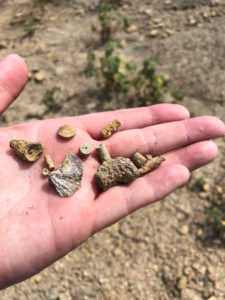
When I was a kid I wanted to be an archaeologist when I grew up.
Now mind you, this was in the days (dark ages) before the Indiana Jones movies, so my parents didn’t quite know what to do with this aspiration, other than try to direct me elsewhere.
I’ve never quite gotten over my fascination with archaeological dig sites, and recently I went to the Mineral Wells Fossil Park where visitors can dig for and keep fossils over 300 million years old!
Think of it as the fossil equivalent of searching for seashells along a beach.
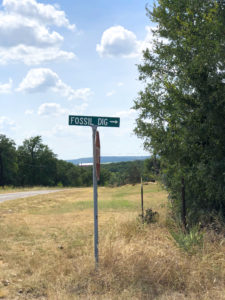 Mineral Wells Fossil Park is a primitive, unique site that’s a fascinating place to explore by yourself or with your family. Offering eight acres to comb, the park used to be the city’s “borrow pit,” which is an area where dirt is taken from to fill other areas. The resulting pit eroded over the 20 years it was used, exposing thousands of fossils from the Pennsylvanian Period.
Mineral Wells Fossil Park is a primitive, unique site that’s a fascinating place to explore by yourself or with your family. Offering eight acres to comb, the park used to be the city’s “borrow pit,” which is an area where dirt is taken from to fill other areas. The resulting pit eroded over the 20 years it was used, exposing thousands of fossils from the Pennsylvanian Period.
It’s one of the few parks in the nation where visitors are legally allowed to remove fossils from the site, taking home true treasures.
There is plenty of parking in the gravel parking lot, where you’ll also find clean, portable toilets, but no running water. If you’re going to want to wash your hands or rinse off a bit after your outing before you re-enter your car bring an extra jug of water.
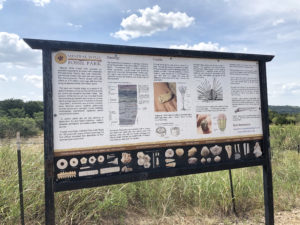
Take time to read the informational signs in the parking lot. They’ll help you to identify things you might otherwise overlook.
If you’d like to take along a “cheat sheet” click this link to find a handy, printable reference sheet of fossil types, courtesy of fossilcentre.com.
The park is primitive in more ways than one. You may encounter dangerous insects or animals (it IS their turf, after all) so keep a sharp eye out for them. And once you descend into the pit, don’t expect your cell phones to work. See? Magic – time travel.
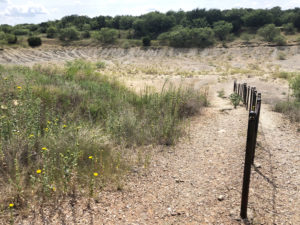
Follow the path to the pit (there’s one way in and one way out to minimize damage to the site). A chain handrail will help steady your balance on the rocky soil as you follow the walkway into the search area.
My visit was on a day after a light rain which was ideal, since it washed the top layer of dust off of things and revealed new items in the channels where water runs down the sides of the pit. I had been told that I wouldn’t really need to “dig” for the fossils since most of them would be laying right on the surface, but I was skeptical. I was wrong . . . and it was amazing.
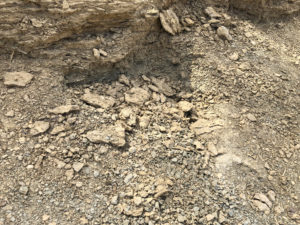 You might find fossils of ancient sea species like trilobites, crinoids (urchins), brachiopods, pelecypods, (clams and oysters), corals, plants, and even sharks.
You might find fossils of ancient sea species like trilobites, crinoids (urchins), brachiopods, pelecypods, (clams and oysters), corals, plants, and even sharks.
The type I found with the least effort were sea lilies (which sound much more impressive when referred to as crinoids). Sometimes called 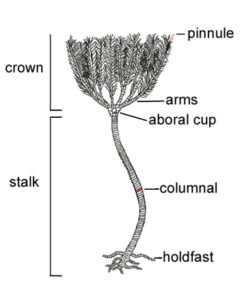 “Indian beads” or “Indian buttons” (what my great-aunt used to call them) in reference to their button or bead-like shape, people used to collect and string them into necklaces. Not to get to “science-y”, but this illustration will show you what where in the plant (columnal) they were originally. Fossils from the other parts of the plant can be found as well.
“Indian beads” or “Indian buttons” (what my great-aunt used to call them) in reference to their button or bead-like shape, people used to collect and string them into necklaces. Not to get to “science-y”, but this illustration will show you what where in the plant (columnal) they were originally. Fossils from the other parts of the plant can be found as well.
Who would have thought a big pit could be so much fun?
Bring a picnic lunch or snacks and PLENTY of drinking water. Even in non-summer months, there is no shade in the actual digging area and you’ll need to stay hydrated. There are no nearby places to eat, so if you’re planning to stay at least a couple of hours (and you should!) your hard-working archaeology crew might get the munchies.
There is a shaded table area as you enter the park that makes a nice place to give yourself and your family a break from the sun. If your visit will be in the summer months, it would be wise to plan to be there early in the day, or late in the evening.
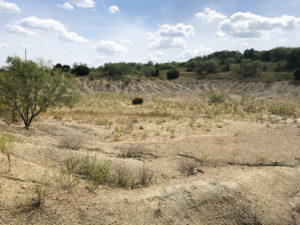
Yes, it’s basically a dirt pit, so dress appropriately. C’mon, that’s half the fun!
You’ll want to make sure everyone has rubber soled shoes (old tennis shoes are perfect) to help with footing on the loose-soiled slopes. (Say THAT 3 times fast: loose soiled slopes, loose sloiled slolpes . . . never mind!)
Other take-along suggestions: baggies or nail aprons to hold your finds, small hand garden trowels to loosen the dirt, an umbrella for extra shade, a wide brimmed hat, sunblock, bug spray, a bucket to c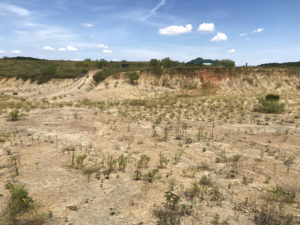 arry tools and water bottles, and a small rubber gardening knee pad to sit on (it’ll feel a lot cushier than the hard ground). As always, please keep a first aid kit in your car to take care of minor boo-boos. Even adults need antiseptic and bandaids, ya know.
arry tools and water bottles, and a small rubber gardening knee pad to sit on (it’ll feel a lot cushier than the hard ground). As always, please keep a first aid kit in your car to take care of minor boo-boos. Even adults need antiseptic and bandaids, ya know.
Oh, and did I mention water? Water, water, water.
You’ll also want to bring along your sense of adventure and patience. Once your brain adjusts to what it’s searching for the fossils seem to become more and more abundant.
Here’s a quick photo I took of the surface at the side of the pit. No, I didn’t even disturb it by beginning to dig! How many fossils can you spot?
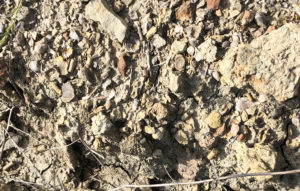
You may even see a few “future fossils” during wildflower season.
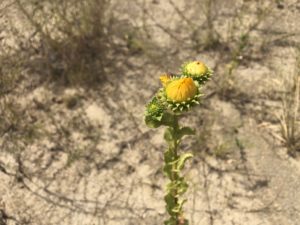
The park address is 2375 Indian Creek Road, just northwest of Mineral Wells, Texas. From Mineral Wells, head west on Highway 180. Turn north on Indian Creek Road and drive approximately 2 miles to the Mineral Wells Fossil Park entrance.
It’s open daily from 8 a.m. until dusk and is admission free, which fits my travel budget just fine.
Personally, I can’t wait to go back. Who’s up for an archaeological adventure?

 Mineral Wells Fossil Park is a primitive, unique site that’s a fascinating place to explore by yourself or with your family. Offering eight acres to comb, the park used to be the city’s “borrow pit,” which is an area where dirt is taken from to fill other areas. The resulting pit eroded over the 20 years it was used, exposing thousands of fossils from the Pennsylvanian Period.
Mineral Wells Fossil Park is a primitive, unique site that’s a fascinating place to explore by yourself or with your family. Offering eight acres to comb, the park used to be the city’s “borrow pit,” which is an area where dirt is taken from to fill other areas. The resulting pit eroded over the 20 years it was used, exposing thousands of fossils from the Pennsylvanian Period. You might find fossils of ancient sea species like trilobites, crinoids (urchins), brachiopods, pelecypods, (clams and oysters), corals, plants, and even sharks.
You might find fossils of ancient sea species like trilobites, crinoids (urchins), brachiopods, pelecypods, (clams and oysters), corals, plants, and even sharks. “Indian beads” or “Indian buttons” (what my great-aunt used to call them) in reference to their button or bead-like shape, people used to collect and string them into necklaces. Not to get to “science-y”, but this illustration will show you what where in the plant (columnal) they were originally. Fossils from the other parts of the plant can be found as well.
“Indian beads” or “Indian buttons” (what my great-aunt used to call them) in reference to their button or bead-like shape, people used to collect and string them into necklaces. Not to get to “science-y”, but this illustration will show you what where in the plant (columnal) they were originally. Fossils from the other parts of the plant can be found as well.







